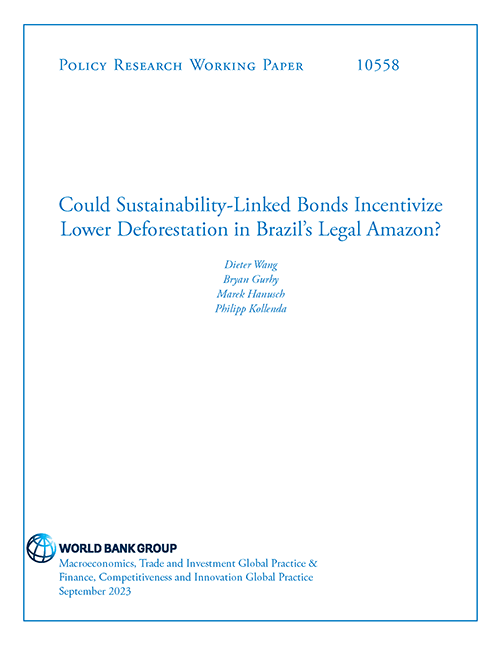
Policy Research Working Paper
Could Sustainability-Linked Bonds Incentivize Lower Deforestation in Brazil’s Legal Amazon?
This paper proposes a new relative evaluation and benchmarking framework for performance-linked financing instruments. It argues that the carrots and sticks of sustainability-linked bonds should not use key performance indicators which are solely tied to outcomes. Instead, they should be based on its issuer's level of performance with respect to a target. The paper defines performance as the part of the outcome that the issuer can influence. Otherwise, the issuer may be rewarded or penalized for factors outside their control. In such a case, principal-agent theory would predict a dilution of the performance-based instrument's incentives. This framework is then applied to deforestation in Brazil's Legal Amazon and estimate performance by accounting for the real effective exchange rate, global commodity prices, and prevalent deforestation trends. The results show that policy efforts helped lower deforestation in the 2000s, even after accounting for external factors. The trend reversal and acceleration in deforestation since 2012 are partly due to weaker policy and macroeconomic factors. Based on these results, the paper proposes an Amazon sustainability-linked bond, which could allow for a more effective mechanism to incentivize policy efforts. The paper also introduces the feasibility and ambitiousness matrix to set sustainability performance targets. The matrix is used to define the terms low-hanging fruits and long shots and to discuss why such targets are subject to the risk of greenwashing.Related blogs
Blog post
Setting a reachable target has been more art than science. Here at the World Bank, we developed the Feasibility-AmBitiousness (FAB) Matrix to give more structure to the target setting exercise. As the name implies, the FAB Matrix gauges targets along feasibility and ambitiousness dimensions. This helps issuers map out possible blind spots and avoid targets that are vulnerable to greenwashing accusations : i.e. highly ambitious targets may not be feasible (long shots), and, likewise, highly feasible targets may not be ambitious (low-hanging fruits).
Read more
Blog post
Recent deforestation alerts suggest that forest loss in the Brazilian Amazon is slowing. This is good news – but also not entirely surprising. Economic models are becoming increasingly able to foretell the direction of deforestation.
In April 2023, we published our projections for Brazil’s Land Use Change and Forestry (LUCF) emissions based on a new macroeconomic model. Back then, we only had official deforestation data until 2021. Nevertheless, the model predicted falling LUCF emissions for 2023 which is consistent with the easing deforestation pressures in the “arc of deforestation” we are now witnessing.
Read more
Blog post
International investors are increasingly interested in promoting sustainable development. Deforestation in the Brazilian Amazon is among the world’s greatest environmental challenges, despite declines from a 2004 peak in Brazil’s Legal Amazon, which includes nine states covering the Brazilian share of the Amazon and parts of two other biomes. Recently, deforestation appears to be accelerating again. Could more decisive government action have averted this recent increase? If so, can financial instruments help incentivize governments to protect critical natural assets like the Amazon going forward? It’s possible.
Read more
Blog post
In an upcoming publication “An Economic Memorandum for the Brazilian Amazon” we introduce the concept of a model-based KPI. The key idea here is that outcome and performance are not the same. Performance is the difference between an observed outcome and would have been expected, based on a forward-looking statistical model.
Read more




